Intel’s Vision of Next Generation Connected Homes
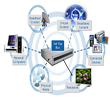 Many of us associate Intel with processors, PC, Server parts and network devices. That is because that’s where Intel has focus most of its marketing efforts; but this is changing because Intel like many other technology companies (Ericsson, Cisco, Microsoft and Motorola) have notice that consumers are working differently with their home appliances, when compare to how we were over the last 20 years. This is why they have coined the term “Consumer Electronic 3.0”. Consumer electronics 3.0, according to Intel is the seamless integration of the internet and television.
Many of us associate Intel with processors, PC, Server parts and network devices. That is because that’s where Intel has focus most of its marketing efforts; but this is changing because Intel like many other technology companies (Ericsson, Cisco, Microsoft and Motorola) have notice that consumers are working differently with their home appliances, when compare to how we were over the last 20 years. This is why they have coined the term “Consumer Electronic 3.0”. Consumer electronics 3.0, according to Intel is the seamless integration of the internet and television.
Intel believes consumers have gone through two phases of consumer electronic technology phases: phase one/Ver.1.0 was the Analog phase of consumer electronic. Consumer then move to phase two/Ver.2.0, this phase was the Digital phase, where most of our home appliances read and produce in a digital format and this is where most of us are at the moment. Intel believes consumer and consumer electronics are moving away from this now to the next phase of the “Connected Home” or “Consumer Electronic 3.0”. In this third phase we will see a coming together of the internet and television.
What is Intel doing to usher in Consumer Electronics 3.0
There are two key areas that I see them approaching this: 1. Helping consumers to interact with their home systems how they want. 2. Help consumer manage and store their home data.
Helping consumers to interact with their home systems how they want
To achieve the first area Intel has developed what it calls a System-on-a-chip (SOC) architecture. Through their SOC architecture Intel is hoping to bridge the gap between home computing and home entertainment. They are hoping that through this technology home users will be able to have a more holistic experience using their television.
According to William O. Leszinske, Jr., general manager of Intel’s Consumer Electronics Group “You must start with superior video and audio experience, because if you don’t have that you won’t be successful. To that great audio and video we have added Intel architecture to bring performance and internet compatibility.”
“We are also building a family of SOCs that are design for set-top-boxes, media players or digital television. Intel has created a unique software framework design to bring the internet to the television experience, it’s based on open internet standards so that it can evolve as the internet evolves and of course it encompasses a TV centric experience.”
“We believe this software framework will benefit everyone in the consumer electronic ecosystem. Consumer of course will get an advantage in that a wide array of applications and services will be made available on the consumer electronic platform. Software developers will have a wide variety of platform and consumers so that they can target with their new application and of course as soon as they build the platform and deliver the application and services they benefit in that they will be a wide array of consumers that can enjoy these new capability and offering. We believe the future of consumer electronic is now.”
Core feature of the System-on-a-chip (SOC) architecture:
- System-on-a-chip integration: cost-effective, small footprint
- High performance Intel architecture processor core
- Decoders for 1080p HD video
- 7.1 surround sound
- 3D graphics
- Designed for set top boxes, media players and digital TVs
- Best architecture for connectivity
Intel’s Vision to help consumer manage and store their home data
Intel would like to be integrated more in the connected home by providing services that not only affect the speed of your computer but how and where your home data is store and manage. Through their “Whole Home Storage Architecture” Intel has realized that “People are generating immense collections of photos and home video, and they are building large music and video libraries consisting of media they buy on the Internet, obtain from friends and family, or purchase in stores.”
Through their research Intel has seen a correlation in the cumulatived purchase of network home devices and home data. They have estimated that by “2010 consumers in the typical networked home will be required to deal with terabytes of data in hundreds of thousands of files, stored and used across ten or more devices.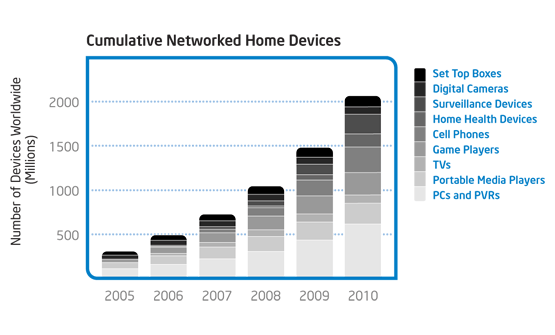
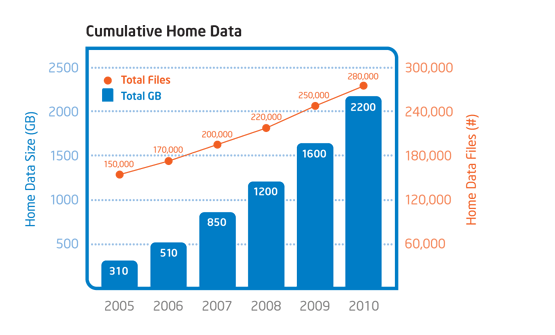
It is clear that today’s storage technology is not in a position to manage our storage need and data in a holistic way or how we would like to manage and interact with the data we keep, for one it is very disjointed. This is one of many other areas that Intel plans to tackle under their whole home storage architecture. “We envision a whole home storage architecture that will bring the familiar, local storage experience to all the data and media in the home.”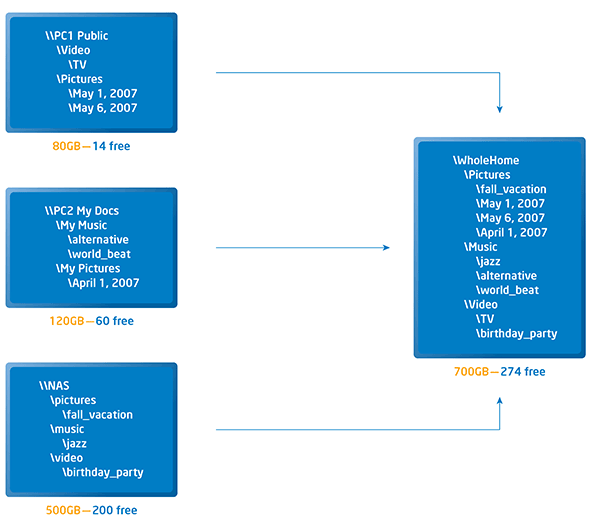
The three areas that Intel thinks the connected home of the future will need from their home storage system are accessibility, performance and permanence.
In terms of accessibility Intel “envision a whole home storage directory structure that provides organized access to all media across all devices within the home. This means that the view across all data should be accessible – and identical – from any connected device”
For permanence “we envision an architecture where the storage resource within the home can be used seamlessly to hold multiple copies of any file. If multiple copies are available, the user sees only one copy. Writes are automatically made to all available copies, providing real-time backup.”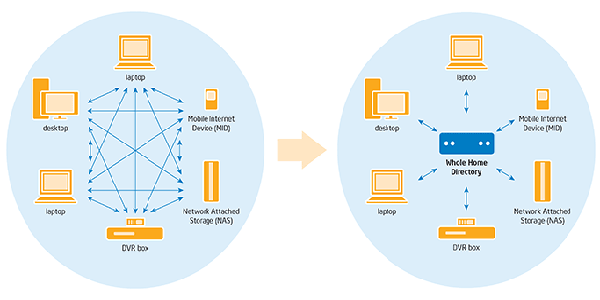
Intel hopes to increase the performance of data access across the whole home network. The accessing of data that is not local to the user should be given the impression that is local in terms of speed of access.
For more information about intel connected home architecture visit: https://www.intelconsumerelectronics.com/Consumer-Electronics-3.0/
*Charts and pictures are courtesy of the intel website.